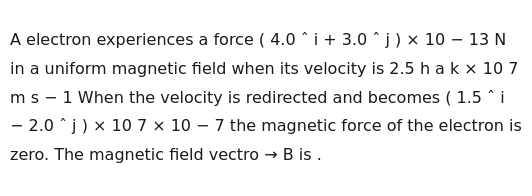Question
Question: A electron experiences a force ( 4.0 ˆ i + 3.0 ˆ j ) × 10 − 13 N in a uniform magnetic field when ...
A electron experiences a force ( 4.0 ˆ i + 3.0 ˆ j ) × 10 − 13 N in a uniform magnetic field when its velocity is 2.5 h a k × 10 7 m s − 1 When the velocity is redirected and becomes ( 1.5 ˆ i − 2.0 ˆ j ) × 10 7 × 10 − 7 the magnetic force of the electron is zero. The magnetic field vectro → B is .

The magnetic field vector B is (−0.075i^+0.100j^) T.
Solution
The problem involves calculating the magnetic field vector given the magnetic force on an electron at two different velocities. The key principle is the Lorentz force law: F=q(v×B).
-
Deduce the direction of B:
The problem states that when the electron's velocity is v2=(1.5i^−2.0j^)×107 m/s (assuming the typo "×107×10−7" means ×107), the magnetic force F2=0.
For the magnetic force to be zero on a moving charge (q=0,v=0), the velocity vector must be parallel or anti-parallel to the magnetic field vector (v×B=0).
Therefore, B must be parallel to v2. This implies that B has no z-component and its x and y components are proportional to those of v2.
Let B=k(1.5i^−2.0j^) for some scalar constant k.
-
Use the first scenario to find the value of k:
In the first scenario, the electron experiences a force F1=(4.0i^+3.0j^)×10−13 N when its velocity is v1=2.5×107k^ m/s (assuming "h a k" means k^).
The charge of an electron is q=−e=−1.6×10−19 C.
Using the Lorentz force law: F1=q(v1×B)
Substitute the known values:
(4.0i^+3.0j^)×10−13=(−e)[(2.5×107k^)×k(1.5i^−2.0j^)]
First, calculate the cross product v1×B:
v1×B=(2.5×107k^)×k(1.5i^−2.0j^)
=(2.5×107)k[1.5(k^×i^)−2.0(k^×j^)]
=(2.5×107)k[1.5j^−2.0(−i^)]
=(2.5×107)k[2.0i^+1.5j^]
Now, substitute this back into the force equation:
(4.0i^+3.0j^)×10−13=(−e)(2.5×107)k[2.0i^+1.5j^]
(4.0i^+3.0j^)×10−13=[−e(2.5×107)(2.0)k]i^+[−e(2.5×107)(1.5)k]j^
(4.0i^+3.0j^)×10−13=(−5.0×107ek)i^+(−3.75×107ek)j^
-
Solve for k:
Equate the coefficients of i^ and j^:
For i^: 4.0×10−13=−5.0×107ek
ek=−5.0×1074.0×10−13=−5.04.0×10−20=−0.8×10−20
For j^: 3.0×10−13=−3.75×107ek
ek=−3.75×1073.0×10−13=−3.753.0×10−20=−0.8×10−20
The values are consistent.
Now, calculate k using e=1.6×10−19 C:
k=1.6×10−19−0.8×10−20=−1.60.8×10−20+19=−0.5×10−1=−0.05
-
Determine the magnetic field vector B:
Substitute the value of k back into the expression for B:
B=k(1.5i^−2.0j^)
B=−0.05(1.5i^−2.0j^)
B=(−0.05×1.5i^+0.05×2.0j^)
B=(−0.075i^+0.100j^) T
Explanation of the solution:
- The condition F2=0 implies that B is parallel to v2. This fixes the direction of B as proportional to (1.5i^−2.0j^).
- The Lorentz force equation F1=q(v1×B) is then used.
- Substitute the known values for F1, v1, q, and the proportional form of B into the equation.
- Perform the vector cross product and equate the components of the resulting force vector with the given F1.
- Solve the resulting scalar equations to find the proportionality constant, k.
- Substitute k back into the expression for B to get the final magnetic field vector.
